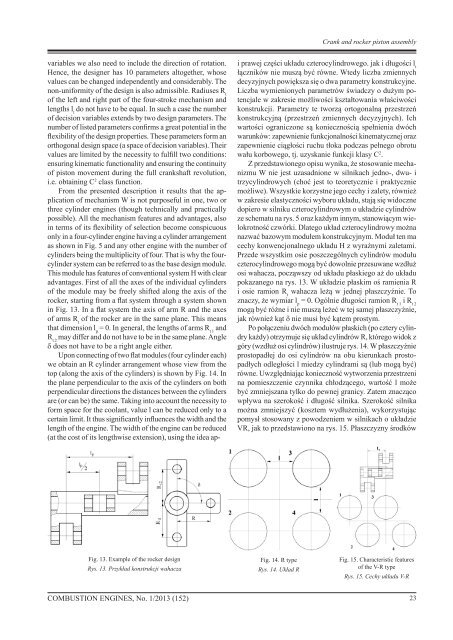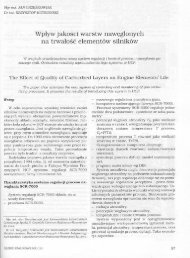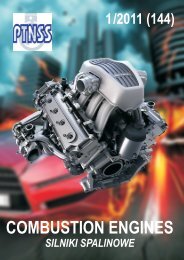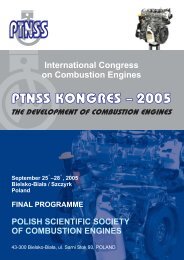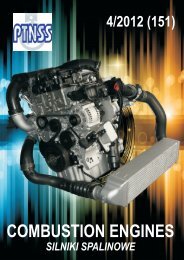You also want an ePaper? Increase the reach of your titles
YUMPU automatically turns print PDFs into web optimized ePapers that Google loves.
Crank and rocker piston assembly<br />
variables we also need to include the direction of rotation.<br />
Hence, the designer has 10 parameters altogether, whose<br />
values can be changed independently and considerably. The<br />
non-uniformity of the design is also admissible. Radiuses R t<br />
of the left and right part of the four-stroke mechanism and<br />
lengths l t<br />
do not have to be equal. In such a case the number<br />
of decision variables extends by two design parameters. The<br />
number of listed parameters confirms a great potential in the<br />
flexibility of the design properties. These parameters form an<br />
orthogonal design space (a space of decision variables). Their<br />
values are limited by the necessity to fulfill two conditions:<br />
ensuring kinematic functionality and ensuring the continuity<br />
of piston movement during the full crankshaft revolution,<br />
i.e. obtaining C 2 class function.<br />
From the presented description it results that the application<br />
of mechanism W is not purposeful in one, two or<br />
three cylinder engines (though technically and practically<br />
possible). All the mechanism features and advantages, also<br />
in terms of its flexibility of selection become conspicuous<br />
only in a four-cylinder engine having a cylinder arrangement<br />
as shown in Fig. 5 and any other engine with the number of<br />
cylinders being the multiplicity of four. That is why the fourcylinder<br />
system can be referred to as the base design module.<br />
This module has features of conventional system H with clear<br />
advantages. First of all the axes of the individual cylinders<br />
of the module may be freely shifted along the axis of the<br />
rocker, starting from a flat system through a system shown<br />
in Fig. 13. In a flat system the axis of arm R and the axes<br />
of arms R t<br />
of the rocker are in the same plane. This means<br />
that dimension l p<br />
= 0. In general, the lengths of arms R t 1<br />
and<br />
R t 2<br />
may differ and do not have to be in the same plane. Angle<br />
d does not have to be a right angle either.<br />
Upon connecting of two flat modules (four cylinder each)<br />
we obtain an R cylinder arrangement whose view from the<br />
top (along the axis of the cylinders) is shown by Fig. 14. In<br />
the plane perpendicular to the axis of the cylinders on both<br />
perpendicular directions the distances between the cylinders<br />
are (or can be) the same. Taking into account the necessity to<br />
form space for the coolant, value l can be reduced only to a<br />
certain limit. It thus significantly influences the width and the<br />
length of the engine. The width of the engine can be reduced<br />
(at the cost of its lengthwise extension), using the idea api<br />
prawej części układu czterocylindrowego. jak i długości l t<br />
łączników nie muszą być równe. Wtedy liczba zmiennych<br />
decyzyjnych powiększa się o dwa parametry konstrukcyjne.<br />
Liczba wymienionych parametrów świadczy o dużym potencjale<br />
w zakresie możliwości kształtowania właściwości<br />
konstrukcji. Parametry te tworzą ortogonalną przestrzeń<br />
konstrukcyjną (przestrzeń zmiennych decyzyjnych). Ich<br />
wartości ograniczone są koniecznością spełnienia dwóch<br />
warunków: zapewnienie funkcjonalności kinematycznej oraz<br />
zapewnienie ciągłości ruchu tłoka podczas pełnego obrotu<br />
wału korbowego, tj. uzyskanie funkcji klasy C 2 .<br />
Z przedstawionego opisu wynika, że stosowanie mechanizmu<br />
W nie jest uzasadnione w silnikach jedno-, dwu- i<br />
trzycylindrowych (choć jest to teoretycznie i praktycznie<br />
możliwe). Wszystkie korzystne jego cechy i zalety, również<br />
w zakresie elastyczności wyboru układu, stają się widoczne<br />
dopiero w silniku czterocylindrowym o układzie cylindrów<br />
ze schematu na rys. 5 oraz każdym innym, stanowiącym wielokrotność<br />
czwórki. Dlatego układ czterocylindrowy można<br />
nazwać bazowym modułem konstrukcyjnym. Moduł ten ma<br />
cechy konwencjonalnego układu H z wyraźnymi zaletami.<br />
Przede wszystkim osie poszczególnych cylindrów modułu<br />
czterocylindrowego mogą być dowolnie przesuwane wzdłuż<br />
osi wahacza, począwszy od układu płaskiego aż do układu<br />
pokazanego na rys. 13. W układzie płaskim oś ramienia R<br />
i osie ramion R t<br />
wahacza leżą w jednej płaszczyźnie. To<br />
znaczy, że wymiar l p<br />
= 0. Ogólnie długości ramion R t 1<br />
i R t 2<br />
mogą być różne i nie muszą leżeć w tej samej płaszczyźnie,<br />
jak również kąt d nie musi być kątem prostym.<br />
Po połączeniu dwóch modułów płaskich (po cztery cylindry<br />
każdy) otrzymuje się układ cylindrów R, którego widok z<br />
góry (wzdłuż osi cylindrów) ilustruje rys. 14. W płaszczyźnie<br />
prostopadłej do osi cylindrów na obu kierunkach prostopadłych<br />
odległości l miedzy cylindrami są (lub mogą być)<br />
równe. Uwzględniając konieczność wytworzenia przestrzeni<br />
na pomieszczenie czynnika chłodzącego, wartość l może<br />
być zmniejszana tylko do pewnej granicy. Zatem znacząco<br />
wpływa na szerokość i długość silnika. Szerokość silnika<br />
można zmniejszyć (kosztem wydłużenia), wykorzystując<br />
pomysł stosowany z powodzeniem w silnikach o układzie<br />
VR, jak to przedstawiono na rys. 15. Płaszczyzny środków<br />
Fig. 13. Example of the rocker design<br />
Rys. 13. Przykład konstrukcji wahacza<br />
Fig. 14. R type<br />
Rys. 14. Układ R<br />
Fig. 15. Characteristic features<br />
of the V-R type<br />
Rys. 15. Cechy układu V-R<br />
<strong>COMBUSTION</strong> <strong>ENGINES</strong>, No. 1/2013 (152)<br />
23


